“Something for me even bigger than mentoring is really listening…When I do that we have a little bit bigger [of a] connection than me being Kendrick Lamar and you being the student. It’s almost like we’re friends because a friend listens.” – Kendrick Lamar at High Tech High School
Reflecting on Kendrick Lamar’s visit to our high school is challenging because there’s so much I want to say. I haven’t even really processed it all, let alone come back down to earth from all the excitement. One of my mentors advised me to, “spend some time with your wife, take a breather, and then start again like this never happened.” I don’t think I’ll ever be the same, nor will my career, our school district, or the students who experienced that day, but I’ll take her words of wisdom. I depend on educators with more experience. I’d be lost without them.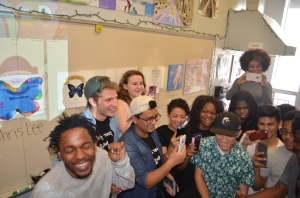
Another mentor often tells me to, “stay low and keep firing.” This means keep your guard up, stay vigilant, remain humble, and keep doing the work. And that’s exactly what I plan to do.
Kendrick’s visit didn’t just happen overnight, randomly, as some media sources have suggested. It was the result of many years of hard work, struggle, mistakes, experimentation, and perseverance. Not just for me personally, but for all the educators who’ve been integrating hip-hop culture into their various classroom spaces for decades in order to engage urban youth in meaningful and culturally relevant learning. This is an uphill battle. Often times, our opponents are the very colleagues, administrators, school boards, superintendents, and parents (and sometimes even the kids themselves!) who we depend on for support.
Teachers have been doing this work for a long time (even before I was born). It’s important to know that teachers of color have been championing the inclusion of hip-hop and spoken word poetry in curriculum for many years. Often times, it’s the white teachers who get celebrated as “progressive” and “forward-thinking” for doing this kind of social justice work, but black and brown folks have been doing it for years. If it weren’t for their guidance, support, and scholarship, I might not even be a teacher. I defer to them all praise and admiration for this work.
Hip-hop education isn’t new, but I believe we’re at a critical crossroads, where the culture of standardized testing, state mandated curriculum, Common Core, and hyper-capitalism have made one thing abundantly clear; teaching and learning must not be confined to a one-size-fits-all model of economic efficiency and profit. Hip-hop education is indispensable in our fight against the privatization of America’s public schools because it is radically democratic and unapologetically transgressive. Hip-hop is a culture of resistance. It is the culture of our young people and we’d be remiss to talk about student-centered pedagogy without including the most influential youth culture of the past 40 years.
I have colleagues who opposed Kendrick’s visit. They heard a “rapper” was coming to school and dismissed the event. Some even refused to attend even after an explanation was offered. Most teachers were supportive though. They understood this was about the kids. It was planned as an educational event from the start, but some still opposed.
The superintendent was supportive from the very beginning. I tried explaining that Kendrick Lamar is a Grammy-Award winning musician, but finally gave up, comparing him to Frank Sinatra so the older, but very wise and progressive leader of our school district might understand the magnitude of Kendrick’s celebrity status. Finally, I showed him some of Kendrick’s music on my phone and he told me, “well, if you’re excited, then I’m excited!” And so the planning began.
 We had production meetings, security meetings, planning meetings, audio/technology meetings – and spent countless hours preparing for Kendrick’s visit to our little high school on Tonnelle Avenue in North Bergen, New Jersey, just a few miles from Met Life Stadium where Kendrick headlined Hot 97’s Summer Jam concert the night before.
We had production meetings, security meetings, planning meetings, audio/technology meetings – and spent countless hours preparing for Kendrick’s visit to our little high school on Tonnelle Avenue in North Bergen, New Jersey, just a few miles from Met Life Stadium where Kendrick headlined Hot 97’s Summer Jam concert the night before.
More than anything else, I wanted to make sure the focus of the event was our students and their work. This wasn’t a promotional event for Kendrick’s music. It wasn’t a photo shoot. It wasn’t a rap concert. It was an educational event – an opportunity for us to show the world that hip-hop music can be “literary” and “educational” – and that it has the potential to prompt powerful, insightful, critical responses from young people.
For this reason, I wanted to have students perform work inspired by To Pimp A Butterfly in order to generate an academic discussion about the value of that work at a school-wide event. I wanted to situate the voices of our students in a larger discourse about urban education and culturally relevant pedagogy. To do that, I leaned heavily on a panel discussion format used by an incredible organization called Urban Word NYC.
Every year, for the opening night of their Preemptive Education Conference in New York City, Urban Word pairs a teen poet with a scholar, often times a professor from NYU or Columbia University. The student performs a poem and the scholar discusses it. This keeps the student’s voice at center of the event and allows the scholar to contextualize the work, responding in a way that highlights the young person’s brilliance, affirms her identity, and shows the rest of us what’s possible when this kind of transaction is made possible. I say transaction because there’s an exchange happening. The young person showcases her work, puts it out for us to hold, contemplate, and move out towards. The young person receives validation, affirmation, and an opportunity to show us her brilliance on a serious scholarly platform.
Yet the scholar, and those of us in the audience, are giving and receiving, as well. We give our attention – not just our intellectual attention, but we listen with our hearts, too. We listen deeply and intently to the young people who are presenting – and this shouldn’t be overlooked. How often do we really listen to young people? How often do we give them the stages and platforms they deserve? Kendrick Lamar fills stadiums regularly, but our young people are doing work so brilliant and creative that stadiums should be filled for them, too. And if we can’t fill a stadium, a school cafeteria will do. A lecture hall will do. An auditorium or gym will do. A field house will do.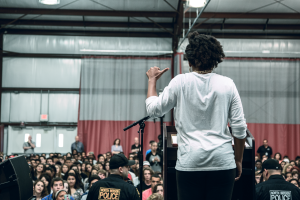
With our students as the focal point for Kendrick’s visit, everything started coming together. We first wanted to give Kendrick time to meet our kids in an informal setting – hang out with them, freestyle in a cypher with our talented MCs, and hear some poetry – so we did that in my classroom with a smaller group of students.
When Kendrick first arrived, I wasn’t star-struck at all. His presence was disarming. He was calm, cool, humble, and maybe even a little awkward. He seemed uncomfortable at first – until we opened up the floor for students to share poetry. He snapped with us, affirming the student-poets, and identifying with them. He said, “that’s dope” and “wow, amazing!” and “they’re incredible!” It was real. It was authentic. He was listening intently, almost leaning over the desk to hear every syllable, every breath, and every word. That’s what good teachers look like – leaning over desks to hear their students – to really hear and listen, seeking to understand. That’s what Kendrick was doing. He was being a teacher.
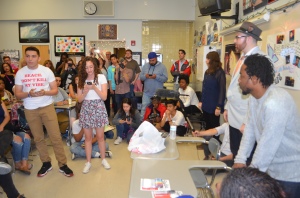 But he also told us about teachers that inspired him, recalling an experience in second grade when, to his teacher’s astonishment, he correctly used the word “audacity” in a sentence. The teacher told him, “you’re going to be a poet one day.” Jokingly, I asked Kendrick if he rhymed “audacity” with another word. He laughed and said no.
But he also told us about teachers that inspired him, recalling an experience in second grade when, to his teacher’s astonishment, he correctly used the word “audacity” in a sentence. The teacher told him, “you’re going to be a poet one day.” Jokingly, I asked Kendrick if he rhymed “audacity” with another word. He laughed and said no.
I find it ironic that “audacity” is the word Kendrick used in second grade. Audacity means, “the willingness to take bold risks.” In many ways, that’s what hip-hop educators are doing. We’re taking bold political risks in our classrooms, pushing back against a Eurocentric ideology that shapes our beliefs, curriculums, schools and classrooms. We’re calling out white supremacy. We’re yelling, “black lives matter!” We’re yelling, “why don’t my students get to read any authors who share their ethnicity!?” These risks are healthy ones – and they are absolutely necessary. People’s lives and freedom depend upon these risks. We must take them. I want to encourage all teachers, young and old, to be audacious in their classrooms. Be unapologetic. Do what you know is good for young people. The work will speak for itself.
When Kendrick arrived at the field house, the whole school was waiting for him. Our panel consisted of scholars from Teachers College, Columbia University, including my mentor, Dr. Chris Emdin – the leader of the #HipHopEd movement. Along with Dr. Emdin, we also had an alumni and our vice principal participate on the panel. This was a deliberate, careful selection of people. We had a scholar / academic, a teacher, an alumni, an administrator, and an artist. In many ways, that group of people represents an ideal circuit for teacher education.
At the university, teachers (me) learn from scholars and experts (Dr. Emdin) and take that knowledge back to their classrooms to work with students (those who performed) – and some of those kids graduate (Greg, our alumni) and take their experiences back to the university, all the while – administrators (Ms. Krone, our vice principal) are observing, supporting, and guiding teachers who are applying these new ideas, inspired by the art created by writers and poets like Kendrick Lamar.
This circuit of teaching and learning involves teacher-education programs, schools, students, administrators, and artists. We should look to this circuit as a model for what’s possible when universities, schools, and artists work together.
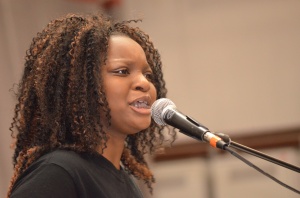 After students performed / presented, the panel of scholars discussed the student work and considered the implications for teaching and learning. I wasn’t sure if Kendrick wanted to participate in this “feedback” or “discussion” part of the event, but we gave him a microphone and had him sit with us on the panel so that he could speak on any of the student work if he felt moved to do so. We didn’t want him to feel pressured to respond. But to my surprise, he was eager and willing to speak about the student work in front of the whole school. He identified with the pieces. He told Sade, a senior, that she just “remixed the whole joint!” after she read her version of “These Walls” which situated her experience as a young woman in Jersey City who is about to go off to college.
After students performed / presented, the panel of scholars discussed the student work and considered the implications for teaching and learning. I wasn’t sure if Kendrick wanted to participate in this “feedback” or “discussion” part of the event, but we gave him a microphone and had him sit with us on the panel so that he could speak on any of the student work if he felt moved to do so. We didn’t want him to feel pressured to respond. But to my surprise, he was eager and willing to speak about the student work in front of the whole school. He identified with the pieces. He told Sade, a senior, that she just “remixed the whole joint!” after she read her version of “These Walls” which situated her experience as a young woman in Jersey City who is about to go off to college.
Kendrick is intellectual, thoughtful, and caring. He didn’t just give generic responses to the student work. He quoted from their poems! He used textual evidence! He told Ben, a senior who read a poem about white privilege, that he respected Ben’s willingness to look in the mirror. Kendrick said that he never realized how his work could transcend Compton and allow all kinds of people to relate to it. I think he was just as inspired by us, as we were by him!
Finally, he treated us to a performance of one song at the end of the day and that was just a huge bonus. We never expected him to perform. It wasn’t part of the program. And no one could have anticipated his final remark: “I’m coming back. That’s a promise.” Until then, we’ll “be alright,” as we continue teach and learn – with audacity – the kind that can’t be silenced.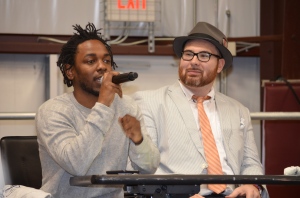

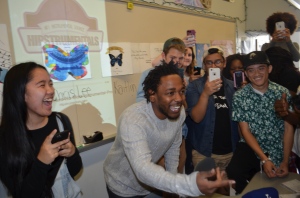

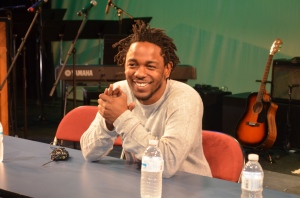


Imagine if different artists that cared about the well-being of students came to different schools. Imagine the inspiration and hope and the change and it definitely looks like all of the hard work and planning paid off.
This is just so great. What a wonderful teacher you are.
amazing!
[…] video below or read the article. Mooney’s original blog post that found its way to Lamar and reflections after the visit are where you can get […]